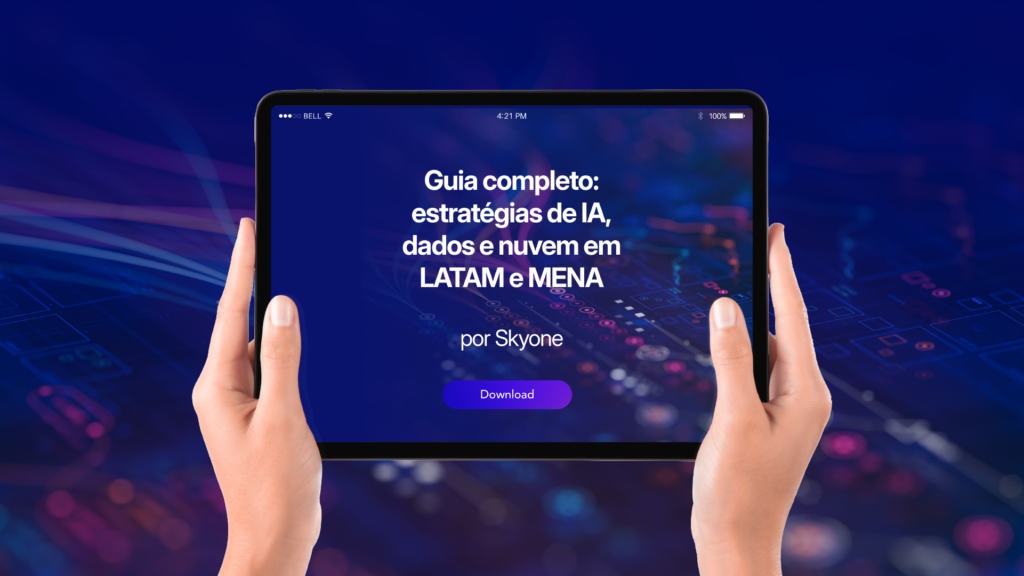Introduction
intelligence (AI) is becoming less and less new - and increasingly a requirement. But between knowing that “I was important” and understanding how it really generates value to the business , there is a little explored territory: the practical and intelligent application of the data that companies already have.
That's where AI agents . They are not generic robots or questions and answers assistants. They are structures capable of acting, deciding and collaborating within automated flows , and all of this, based on the data that circulate (or is forgotten) in corporate systems.
This new dynamic has gained strength with the rapid evolution of generative models. According to a McKinsey report , 40% of companies that already use are specifically investing in natural language -based automation and autonomous decisions - an advance that points to a structural change in the way organizations operate.
In this content, we will objectively present what AI agents are, how they work, and why they represent a step forward in digital maturity , especially when connected to real, integrated and governed data. In the end, you will meet Skyone Studio : Our unique platform designed to transform AI complexity into smart, scalable and possible decisions.
Let's go!
What are AI agents?
Today, it is easy to interact with artificial intelligence. Whether in a text tool, an image search, or a chatbot , access to AI has become simple and daily. But in the corporate universe, access is not synonymous with value. The real impact comes when AI acts in an integrated way, with autonomy and purpose. This is where AI agents enter.
AI agents are intelligent structures that operate based on goals, data and context . Unlike traditional automations that perform repetitive tasks under rigid rules, agents interpret scenarios, make decisions and perform actions - all autonomously . And most importantly, they do this about the real data of the company, in integrated environments, with governance and focus on results.
In the personal use of AI, the experience is often superficial: the user interacts with public data, in punctual and isolated actions. In the business context, agents need to deal with strategic, confidential and complex information - which requires not only technology, but maturity of clear data, structure and objectives.
The analogy with motorsport helps to visualize this scenario. A modern running car is not just about power: it requires integrated sensors, real -time decisions and intelligent strategies. AI agents operate in the same way: they are digital pilots that work in high performance, based on accurate data , to deliver quick decisions and aligned with business objectives.
MAIN CHARACTERISTICS
AI agents combine autonomy with strategic intelligence. Among its most relevant abilities are:
- Objective-oriented decision : Each action is guided by defined goals, not just pre-programmed commands;
- Contextual Memory : Agents learn from previous interactions and adjust their behavior over time;
- Collaboration between Agents : Different agents can act together, in sequence or in parallel, to fulfill steps of the same flow;
- Action on Real Data : Corporate data is the basis of operation, not just external or generic inputs
These characteristics allow agents not only to automate processes, but make decisions that make sense to the context of each company, increasing efficiency and reducing dependence on manual tasks.
Difference between AI agents and other traditional automations
Traditional automation is based on fixed rules, and it works well when the scenario is predictable . But just one variable outside the script so that everything stops or depends on human intervention.
AI agents , on the other hand, comprise the scenario in real time . They evaluate alternatives, choose the best paths and learn from the results. This allows resilience to the unforeseen event and constant adaptation, indispensable qualities in volatile business environments.
Another central point is that traditional automations do not learn, but perform. The AI agents evolve . With each new interaction, AI accumulates data, refines decisions and delivery more value.
However, this intelligence only flourishes when the company has a solid data base : structured, accessible and connected. In other words, it is not just about using IA, but of preparing the terrain so that it really works.
Now that you have understood what AI agents are and why they differ from traditional automation, it's time to go beyond the concept. Next, we will show you how they operate in practice - from data reading to autonomous tasks and decisions.
How autonomous flows work with AI agents
So far, we have seen that AI agents are structures that act with autonomy and intelligence, interpreting data and making decisions aligned with business objectives. But how does this performance happen in practice?
The operation of an agent involves more than the execution of tasks. It follows a continuous cycle of data entry, interpretation and action , which can be repeated hundreds of times on a single journey, always adjusted to the context.
Two aspects deserve attention. First, the steps that make up this cycle , from the arrival of the information to the delivery of a system response or activation. Then what really differentiates this process from conventional automation : the agent's ability to learn, reflect and continually improve.
It is about these two pillars that we will go deeper.
Basic steps: from input to the execution of tasks
AI agents work in cycles, but not in a cast. They interpret, decide and act based on context, and this process can be divided into four main steps :
- Input - Data entry : The agent receives real -time information from various sources, such as internal systems, platforms, sensors, APIs, integrations. It all starts here: without data, there is no action;
- Processing - Interpretation and Analysis : More than reading the data, the agent comprises the scenario. It crosses information, evaluates patterns, identifies needs and understands which action is most aligned with the goal;
- Decision - Choosing : Based on the analysis, the agent chooses the best way, and this choice is flexible. If the context changes, the decision changes as well;
- Execution - Activation and Answer : Finally, the agent acts: triggers an action, sends a command, updates a system or conversation with another agent. And soon returns to the beginning of the cycle, ready for the next input .
This sequence transforms the agent into an intelligent and continuous operator , not only automating tasks, but coordinating actions with agility and context.
Use of memory, reflection and reasoning in intelligent agents
The intelligence of AI agents goes beyond execution. This is because they are also able to accumulate knowledge, adjust behaviors and evolve over time . Understand:
- Memory allows them to take into account previous experiences, past results, recurring contexts
; - Reflection enters when the agent analyzes what he did, understands what worked and what can be adjusted, without depending on human reprogramming
;
Reasoning connects all this to a greater goal: each decision is made based on the impact it will have on the results it seeks to achieve .
This active intelligence makes agents stop being mere executors and become true digital collaborators, capable of responding, learning and continually improving.
However, this level of sophistication is only supported by a solid base. As already discussed in real implementation processes, agents only operate accurately when data is organized, accessible and well governed .
That is, as in Formula 1, a fast car is not enough. Without telemetry needs, without track reading, no performance history, there is no way to make good decisions in real time. With AI agents, the principle is the same: intelligence only accelerates when anchored in real data .
For this level of autonomy to work, agents need fluid access to the data, and an environment capable of integrating it all in a coordinated way. It is about this invisible but essential infrastructure that we will talk about in the next section. Follow!
Data integration and orchestration of actions with agents
Autonomy is not born out of nowhere. For IA agents to operate with intelligence and fluidity, it takes an invisible but decisive basis: the ability to access certain data, to understand what they mean and coordinate actions between different fronts of the company.
This technical background is what differentiates an isolated automation from intelligent operation. In other words, this is where AI is no longer experimenting and becomes a result .
But this transformation does not happen in a single step. It requires a set of complementary capabilities, such as: access to the right data, in the right format, at the right time; Fluid connectivity between distinct systems, without friction; and coordination between different agents and specialties, in articulated flows.
These are the three pillars that make the autonomy of the agents possible , and we will see below.
How agents access and use corporate data
AI agents do not just read data: they need to understand it .
Each information only becomes useful when it is inserted in a business context . A number of billing, for example, can act a review of goals, inventory adjustments or anticipate a marketing - as long as the agent understands what that number represents.
For this, data need to be accessible, well organized and in a format that allows interpretation based on objectives. This condition depends on structural maturity : governance, standardization and a clear database as active.
When this base exists, the impact of agents increases exponentially. And the operational effort to manage them, on the other hand, decreases .
Interoperability between systems via Ipaas
Modern companies operate with dozens, sometimes hundreds of different systems such as ERPs, CRMS, cloud platforms, legally and APIs, etc. And each speaks their own language .
To circumvent this, Ipaas ( Integration Platform as Service ), a software layer which acts as a universal translator between these systems , allowing them to share data continuously and safely - without the need to develop zero integrations for each connection.
At Skyone , our Ipaas was created precisely for this: to translate this multiplicity into a unique logic of integration . It connects, adapts and ensures that data flows between systems accurately without requiring deep restructuring. This allows AI agents to access information in real time, regardless of where they are stored.
We can think of this operational fluidity as the sync of a high performance car : engine, suspension, sensors, brakes - each component acts independently, but all operate in full tune.
When this happens, the system responds with accuracy and speed , and that is exactly what Ipaas provides the AI operation.
Orchestration of specialized agents and skills
True autonomy goes beyond individual action. It emerges when multiple agents , each with a specific function, work in network, with shared logic and precise coordination .
This model is what we call componable intelligence : a structure in which different agents collaborate in a modular way, triggering specialized skills according to the need for each flow.
For example, an AI agent may interpret sales data. Another, predict demand. A third, validate stocks. And they all communicate, share results, and drive the next step without dependence on human intervention.
With this, the company starts to operate with smart flows that set up and adjust in a dynamic way. Each action is part of a wider system, where agents work as a team of digital experts: synchronized, agile, accurate .
The result? An operational model capable of climbing without losing control! Less manual effort; more real time intelligence.
With organized data, interperoper systems and agents acting in a coordinated manner, the base is ready. But what is the impact of this in business daily? What really changes in productivity, scalability and operational efficiency? This is what we will explore below.
Advantages of AI agents for companies
Data integration, orchestrated flows and AI agents autonomy form a powerful base - but what does this mean in practice for companies?
True value appears when these capabilities translate into efficiency gain reduction of operational effort and more time dedicated to what really matters : strategic decision making. Understand below.
Reducing manual effort and increased productivity
Companies spend valuable hours on repetitive tasks : spreadsheet consolidation, system updates, manual validations, operational communications, etc.
With AI agents, these actions are performed autonomously, in continuous cycles, based on updated real -time data. The results are:
- Less human effort in operational tasks;
- More time and focus of the team for relevant decisions;
- Processes that do not stop, even outside business hours.
In addition to relieving bottlenecks , agents guarantee consistency . This is because the same flow can be repeated hundreds of times with the same quality standard, without errors or deviations.
In other words: productivity ceases to depend exclusively on the team's available time , and starts to climb with the intelligence applied.
Scalability and intelligent automation with lower operating cost
In a growth scenario, climbing processes cannot mean multiplying costs . With componible and reusable AI agents, it is possible to expand flows, create new journeys and integrate new systems without having to start from scratch.
Each new flow can take advantage of existing skills , and be adjusted quickly based on business rules or real -time data. In addition, agents make decisions based on context. This avoids rework, reduces errors and decreases the need for human support in common situations.
In practice, this means that the company can grow, serve more customers, integrate more operations without increasing its personnel structure or technological load . Thus, AI is no longer an additional cost and becomes an efficiency lever and sustainable scale.
All these benefits are no longer promise of the future: they are already reality, of course, when supported by a modern, safe and fluid architecture .
Next, you will meet Skyone Studio : our platform that makes all this possible by putting data, integration and intelligence to operate as one thing. Check it out!
Skyone Studio: The platform that unites data, integration and AI agents
After understanding the impacts of AI agents on companies, the essential question arises: How to apply this intelligence, with governance, scale, and operational simplicity?
The answer is Skyone Studio , our new platform designed to turn complexity into fluidity. It combines data, integration and intelligent automation into a single structure , capable of converting data into decisions in real time.
Its architecture consists of four main layers :
- IPAAS : connects more than 400 systems, with visual workflows and hybrid integration;
- Lakehouse : Structure given with governance, allowing segmented access and real -time updates;
- AI agents : operate with reasoning, memory, goals and reusable skills; and
- Conversational Platform with BI : Allows interactions via WhatsApp, Telegram, chat and integrations with dashboards such as metabase and power bi.
Together, these components act like the systems of a high performance car: each piece has its function, but the victory only happens when everything acts in a synchronized way .
As IA agents operate on real data with governance
In Skyone Studio, artificial intelligence does not operate in the dark . It acts based on living, updated and governed data.
This is possible thanks to Lakehouse , a modern architecture that combines the best of data warehouses (organization and performance for analysis) with data lakes (flexibility and scale). It allows you to store, organize and segment data in real time, with structured access, version and native interoperability.
With this, each data accessed, each decision made and each action performed has a clear origin, a defined context and a traceable historical .
This allows us to deliver intelligence with control , one of the biggest demands of companies today. Because governance is not accessory: it ensures that AI does not become a black box, but a reliable source of decisions.
In practice, it is as if each agent worked with a full cockpit : knowing what happened before, what is happening now and how it affects the next steps.
Intelligent, multichannel and real -time monitoring flows
Studio Skyone has also been designed to reflect the actual complexity of everyday corporate day to day : different channels, simultaneous demands, decisions that cannot expect. Therefore, the flows are:
- Multicanal : Agents act by WhatsApp, Telegram, Chat or Dashboards - the data comes where it needs to arrive;
- Componable and reusable : flows can be mounted with existing agents and skills, adapted without redoing everything from scratch;
- Real Time Adjustable : With continuous monitoring and dashboards that act as the telemetry center of a technical team.
Each decision is made accurately. Each adjustment is made without interruption. That is, it is going without pitstop , flowing along with the business, learning with each curve and delivering continuous performance.
If you want to understand deeper into how Skyone Studio can turn your business flows with safe, integration and real intelligence, our team is ready to talk! Speak now with a skyone expert and find out how to take the first steps on a more productive, fluid and future journey with the future.
Conclusion
Artificial intelligence lives a new chapter. It is no longer just about providing trends, but of turning them into concrete action , based on the data that each company already has, and of course, the goals it still wants to achieve.
This is where AI agents gain protagonism: they act with autonomy, reasoning and context, without depending on scripts or generic responses . They learn, collaborate, make decisions. But above all, they do this with focus on results that matter.
As we have seen throughout this article, this intelligence really works only when there is a structure for it to work : well organized data, integrated systems, scalar flows.
Not by chance, those who lead with AI today are not just accelerating tasks. It's changing the way of thinking, deciding and operating . As with a strategic race, the differential is not only at speed, but in the ability to read the circuit, adjust in real time and keep the performance even under pressure.
At Skyone , we believe that real technology is one that translates into impact. And what intelligence is not just what I do: is what it allows you to do better .
Want to follow this transformation closely? Here, on Skyone's blog we are always open for those who want to see besides hype and consistency to build the next step of their digital journey. Check out others of our content!
FAQ: Frequently asked AI agents
Artificial intelligence agents (AI) have been gaining prominence in companies of various sizes and sectors. But how does this technology really work in practice? And what is important to consider before adopting it?
Below, we answer the most common questions on the topic, directly, strategically and updated.
1) Which sectors benefit from this technology the most?
Sectors dealing with large volumes of data, repetitive processes and continuous operational decisions are the most benefited, such as retail, logistics, financial, health, industry and services. However, technology is versatile: any company that wants to automate intelligently, reducing manual effort and gaining agility can adopt AI agents with real impact.
2) How to start using AI agents in my company?
The first step is to ensure that the company has a minimum structured and affordable data base. Then it is essential to map operational flows that can be automated with intelligence. Platforms like Skyone Studio allow you to start with simple agents, taking advantage of existing data, and gradually evolve, always with control and visibility.
3) AI agents need large data volumes?
Not necessarily. What matters more than volume is quality, organization and context of data. AI agents operate better when data is updated, well defined and connected to clear goals. Even with smaller bases, it is already possible to generate value - as long as the right data is available at the right time.
4) Is it possible to integrate AI agents with legacy systems?
Yes. Today, using integration platforms (such as Ipaas), you can connect AI agents to legacy, ERPs, CRMS and other environments without restructuring everything from scratch. This allows you to modernize the operation gradually, taking advantage of what already works and accelerating with intelligence, without major impacts on the existing architecture.

LUIZ EDUARDO SEVERINO
Passionate about artificial intelligence and its real -world applications, Severino explores how AI can transform business and boost innovation. On Skyone's blog, he demystifies trends, explains advanced concepts and shows the practical impact of AI on companies. Connect with Severino on LinkedIn: https://www.linkedin.com/in/Leaddoseveneven/




